Cinerama Birthday |
Read more at in70mm.com The 70mm Newsletter |
| Written by: Mark Trompeteler. All photographs by the author with thanks to the museum’s press office | Date: 31.07.2014 |
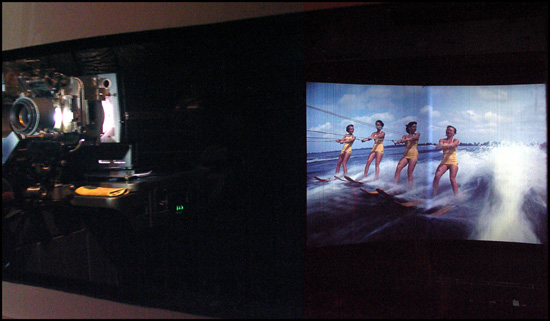 Old & Rare Old & RareCinema professionals, writers, academics and fans travelled from all over the world to this year’s Widescreen Weekend, at the National Media Museum in Bradford. Mark Trompeteler reports on Cinerama’s very own UK based “Diamond Jubilee” celebrations. The largest number of core delegates, in the region of 180, that the museum staff can ever remember attending the Widescreen Weekend gathered at the museum’s Pictureville Cinema in late April. Not only to celebrate all things widescreen, but particularly this year, Cinerama’s sixtieth birthday. So why in these days of digital and automated screenings of crisp, stable, high resolution images in Cinemas does a dedicated hardcore of professionals, academics and fans still enthuse about and celebrate such an old and now very rare projection system? Furthermore that system not only highlights all the problems with film prints, but threefold, not to mention join lines when the three prints are projected side by side. Pictureville Cinema at the museum is also only one of three remaining public cinemas in the world capable of being able to screen Cinerama “three strip” prints, which are so rare and deteriorating. Quite simply it is because Cinerama irrevocably, in one fell swoop, totally changed the shape and sound of the movies for evermore. |
More in 70mm reading: Widescreen Weekend, Bradford, England Internet link: |
Big Screen Impact |
|
|
At a time of the rapid growth of television in America and falling
cinema audiences, the premiere of “This is Cinerama“ in 1952,
even with its limitations of the join lines, caused an audience
sensation. The major Hollywood studios subsequent rapid introduction of
widescreen aspect ratios and stereophonic sound made a counter attack on
television, which in its turn eventually adopted widescreen and
multi-channel sound itself. Despite only nine “three strip” feature
films ever being made, and some arguably coming across as quite dated in
narrative appeal by today’s standards – the impact of Cinerama is worthy
of celebration and this year’s Widescreen Weekend did just that so well.
It is also easy to forget with its encompassing deeply curved screen and the very wide field of vision presented to the viewer that Cinerama also, in its own way, addressed the immersive effect of big screen Cinema and 3D that audiences could find attractive both then and today. Two years ago in another article, I alluded to this when I said: “To my mind one of the particular relevancies of Cinerama to digital age young people is that it was a utilisation of the peak of moving image projection technology, photographic emulsions, presentation and sound technology of the day to produce probably the very first mass audience immersive virtual reality or virtual world experience. “ It was the film Imax of its day. |
|
Cinerama Legacy |
|
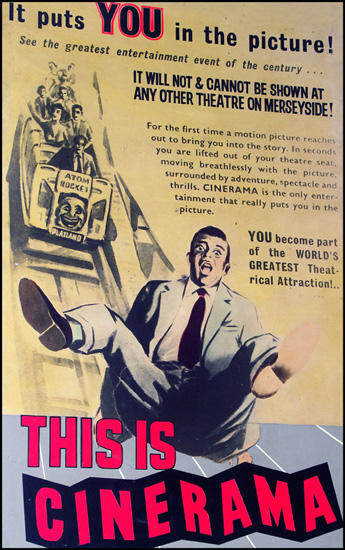 On asking some delegates what they thought the importance of Cinerama
has been in the history of cinema similar strands of thoughts were
expressed: On asking some delegates what they thought the importance of Cinerama
has been in the history of cinema similar strands of thoughts were
expressed: "Nearly 60 years after the dawn of the cinema, Cinerama brought the third generation of movie-goers a vivid reminder of the visceral thrill of moving images that had first entranced their grandparents to jump out of their seats thinking a steam train was going to come right off the screen and run right over them.” Randy Gitsch, Hollywood, (Cinerama Expert & Historian, Film Archivist, Producer “Keepers of The Frame”, “Cinerama Adventure”, Collaborator on Digital Cinerama Presentations.) “The historical importance of Cinerama, cannot be overstated. Cinerama gave the cinema, an industry nearly killed by television, a whole new lease of life.“ Mark Lyndon, London, (Writer and Regular Contributor to www.in70mm.com) “The importance of Cinerama in the history of cinema was that its box office success opened the eyes of the film industry to the advantageous use of improved technology to enhance the realism of the movie going experience and using this as a tool to combat the inroads of television on their business. “ David Coles, Australia, (A Career in Cinema Exhibition, Cinerama Expert & Historian.) “The Hollywood studios, unable to ignore Cinerama's phenomenal success, adopted numerous copy-cat formats during the years that followed. As a result, Cinerama was the driving force for changes that can still be seen in how films are made to this day.“ Tom March, Canada, ( Ex Broadcast Engineer, Cinerama Expert & Collaborator on Current Cinerama Projects. ) “Cinerama forever changed the way movies were both made and presented because the very first film in the process gave birth to an era of widescreen cinema which has remained to this day and which is still as pertinent and relevant as it was in 1952.” Duncan McGregor, (Projection Manager and Programmer, Widescreen Weekend.) |
|
Gance, Brownlow & Cinerama |
|
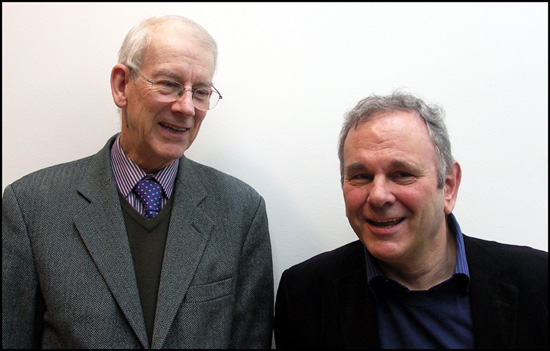 Kevin Brownlow & Mark Lyndon
share a joke Kevin Brownlow & Mark Lyndon
share a jokeI recently wrote about a Photoplay Productions’ magnificent Parisian screening of “Napoleon” and the impact of Able Gance’s final twenty minute triptych and how I thought in many ways Gance had conceived of and achieved Cinerama well ahead of Fred Waller’s development of it. It’s a view held by some. Kevin Brownlow was one the speakers at this year’s weekend and very kindly agreed to an interview with me about Cinerama, “The Artist” and Digital Cinema – more of which perhaps in a future issue of CT. However, during our interview and conversation he told me that his partner at Photoplay, Patrick Stanbury firmly believes Cinerama is very significantly a development on and different from Gance’s triptych. Brownlow told me that Stanbury argues it’s the arrangement of the projectors cross projecting onto the deeply curved screen that makes it significantly different – which causes me to re-evaluate my former view that Gance got their first. |
|
The Glories of “Three Strip” |
|
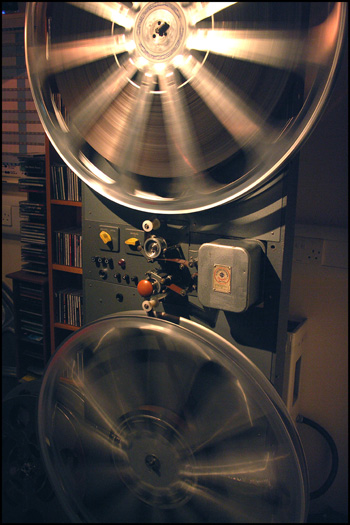 Cinerama Magnetic Multi Channl Sound Reader Cinerama Magnetic Multi Channl Sound ReaderOf the nine* “three strip” feature films made five were screened over the weekend either in original “three strip” prints or digitally, together with excellent introductions and accompanying presentations. ( * Cinerama experts can disagree on this point – please note “Scent of Mystery” aka “Holiday in Spain” was shot in 70mm and then “three stripped” afterwards. “The Best of Cinerama” was not a new film but a compilation, and other titles from the Cinerama Library were originated on 70mm, so some experts maintain that only nine original “three strip” feature films were ever made. ) The three strip prints screened were “This Is Cinerama”, (TIC), “How The West Was Won”, (HTWWW), and a long awaited and highly anticipated screening of “The Wonderful World of the Brothers Grimm”, (WWWOTBG). The first two are well known and have been viewed by Widescreen Weekend regulars quite frequently over the years but improvements have been made to the museum’s print of TIC by the reprinting of a section or two of the print. (courtesy of Cinerama Aficionado Tom March). Something worth mentioning is the point that Duncan McGregor of the museum staff highlighted at the weekend. “The prints of HTWWW and WWWOTBG were made possible by a few dedicated and generous widescreen enthusiasts who enabled this project to happen, by helping sponsor the cost of shipping these prints from Australia. If I hadn’t been able to raise this money from the outset, then the weekend would have been very different as we couldn’t afford to ship them for just one or two screenings – so the sponsorship was vital. “ This year’s screening of HTWWW was made special in that it was a print obtained from private collector, John Mitchell, and a screening of a short documentary of the cast reminiscing about the making of the film was also included. Also particularly by the attendance of and a presentation by Loren Janes – a veteran Hollywood stunt man and stunt co-ordinator, who has worked on many Hollywood classics, and worked with many Hollywood “greats”. His presentation on the work that he did on HTWWW made the screening this year particularly special. What was probably the Cinerama highlight of the weekend and which probably accounted for many people travelling around the world to come to see, was the incredibly rare public screening of a “three strip” print of “The Wonderful World of the Brothers Grimm”. Probably one of the last surviving “three strip” prints of the film – it had been rescued and looked after over the years, along with other Cinerama prints and equipment by legendary, almost folkloric, Australian private Cinerama collector John Mitchell. Now a retired telecommunications professional, and at one time, a part-time projectionist, and dedicated film enthusiast, John had rescued Cinerama prints and equipment and saved them from oblivion many years ago and to this day has a private al fresco Cinerama installation in his back garden. As generous a “diamond jubilee” gesture as you can imagine he had parted with this extremely rare print which was shipped over from Australia for this very highly awaited screening. John also made a brand new 35mm full coat oxide, 7 channel soundtrack to accompany the print, as his original sound print was in the final stages of vinegar syndrome and almost beyond saving. It was rescued at the last minute and once again generously sponsored by Tom March. Furthermore, after delicate negotiations with Duncan McGregor, he agreed to donate this unique Cinerama print – along with HTWWW – to the National Media Museum’s film archive. On the Saturday night a full house buzzed with excitement knowing this was understood to be the first public screening of this film in original “three strip” Cinerama for some forty years! As soon as the film appeared on the screen I was reminded at just how amazing Cinerama still can be and must have been in its heyday. The rich Technicolor print, remarkably crisp and in good condition in large sections presented so much visual information and detail on the screen, so much so that even in this 4K digital age, it still took my breath away. Particularly in one sequence - in the gypsy camp - the deep rich use of Technicolor combined with the immersive and detailed Cinerama experience really did create a convincing virtual reality kind of experience. For me this old Hollywood family “feel good” type of movie, which I had never seen before, was a revelation in the way it showcased Cinerama and worked so effectively as a film of its type, and of its time. It was a particularly moving moment when a skype broadcast from the museum to John’s home in Australia brought an image of John onto the cinema screen in Bradford which was greeted with immediate spontaneous and enthusiastic audience applause. Bill Lawrence chatted on skype with John and conferred admission to The Widescreen Academy to John, in recognition of his amazing contribution to the preservation of the legacy of Cinerama. |
|
Digital Cinerama |
|
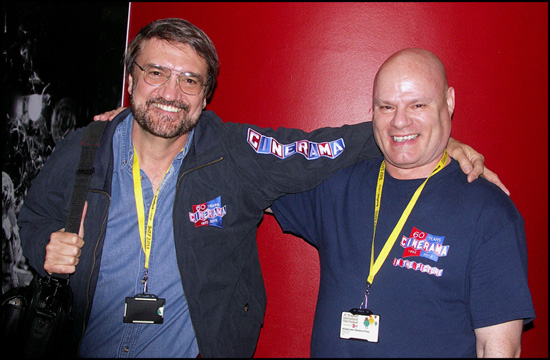 Dave Strohmaier & Randy Gitsch & Projecting Cinerama Dave Strohmaier & Randy Gitsch & Projecting CineramaDave Strohmaier and Randy Gitsch often point out that they do not undertake full blown film restorations of Cinerama feature films. What they have been doing on amazingly low budgets is a digital scanning in of the best film material they can obtain of the these films, and then a digital “clean up” and colour restoration within the digital file and then the production of the final file. It is a kind of re-mastering, transmutation or transformation of film material to 2K digital files. The purpose of this is to have material available for screening on digital formats and to make available commercial Blu-ray DVDs so that people could buy and add to their collections and make this film heritage available to the home market. This is something that is being achieved at a fraction of the cost of a full blown restoration back onto film material. In achieving this work Tom March says, “Enough cannot be said about Image Trend’s contribution in restoring the four travelogues. Their contribution included drawing up a special contract to scan all four travelogues while staying within Cinerama’s budget. They also funded the modification of their digital scanning equipment to accommodate the now discontinued 6-perf Cinerama format and they came up with the software to combine the three digital panels into one digital image.” Clearly Image Trends made a significant contribution to help preserve these Cinerama classics. This year Dave & Randy introduced and screened two of their digital “re-masters” - “Russian Adventure” and “South Seas Adventure”. Invariably file sizes and the variation in the quality of the original film material they are able to obtain is going to affect the outcome. From memory, the re-mastering of “South Seas Adventure” on the Pictureville’s screen looked somehow perceptibly better than the digital version of “Windjammer” screened a couple of years ago. But a simple piece of information from Randy confirms that with their work on “Windjammer” the best material they could obtain were dupes of dupes, whilst they were able to obtain original negative material for “South Seas Adventure” – whilst such variations show up on a very big cinema screen – such variations will be far much less noticeable on home cinema screens. The screening of “South Seas Adventure” was again made special by the guest attendance of Ramine – who featured prominently in the film and attended the world première of the film in 1958. This year was the première of the digital version of the film and her attendance at this second one, some 54 years later, must have established some kind of Cinema world record! David Coles from Australia also gave a detailed presentation on the history of the making of the film. The contribution that Dave and Randy continue to make to the preservation and championing of Cinerama heritage is truly outstanding. |
|
Other Widescreen Items |
|
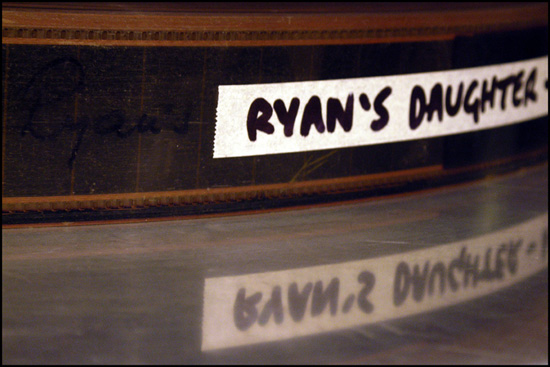 The presentation of 70mm prints of “Ryan’s Daughter”, “Around
The World in 80 Days”, “Star Chamber” and “Black Rain”
ensured that Cinerama wasn’t the only item on the weekend’s programme.
Kevin Brownlow presented a lecture: “From Biograph to Fox Grandeur.
Early Experiments in Large Format Presentations”. His attendance and
contribution were greeted enthusiastically. The presentation of 70mm prints of “Ryan’s Daughter”, “Around
The World in 80 Days”, “Star Chamber” and “Black Rain”
ensured that Cinerama wasn’t the only item on the weekend’s programme.
Kevin Brownlow presented a lecture: “From Biograph to Fox Grandeur.
Early Experiments in Large Format Presentations”. His attendance and
contribution were greeted enthusiastically.Another highlight was the Sunday evening presentation of the film “Samara” shot on 65mm and projected in 4K digital. It was the UK première of the film and the closing film of the whole Bradford International Film Festival. It was also Pictureville’s first presentation featuring 7.1 surround sound made possible via the UK’s first install of Datasat Digital’s latest audio processor – the AP20 (more of which will feature later in a separate article in CT.) Directed by Ron Fricke it is his follow up to his “Baraka” and these are reminiscent of the beautiful non verbal films of Godfrey Reggio “Koyaanisqatsi” and “Powaqqatsi”. It’s a non narrative observational documentary with no dialogue or voiceover, a thematically edited film exploring certain traditions, religious ceremonies, customs, the beauty of landscape and beautiful locations set against an increasingly urbanised and modern world with aspects of modern life also depicted. The film is visually stunning, shot with an acute photographic / cinematographic eye. A film constructed in such a way that shown to audiences so used to narrative films with a story and dialogue, it may not be something that is to everybody’s taste. I really enjoyed it. It is visually fabulous and subtley evokes questions in the viewer about the world, our beliefs and values, and modern life. As a showcase that demonstrates the visual beauty of stunning 65mm film origination quality and the stunning crisp stable quality of 4K presentation - it was brilliant. |
|
Justified Recognition |
|
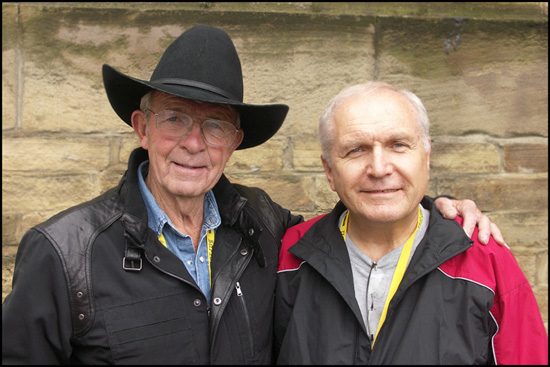 Loren Janes & Tom March Loren Janes & Tom MarchThe number of people who contributed to this year’s very special Widescreen Weekend must have been many and varied and as always recognition must go to the this year’s programming team of Bill Lawrence and the museum’s Duncan McGregor, and all the museum staff involved. Mention has already been made of the public recognition bestowed by the organisers of the invaluable contribution of John Mitchell to the legacy and heritage of Cinerama. Similarly the organisers gave very special recognition of the work of Kevin Brownlow and his contribution to widescreen and cinema appreciation and history. Organisers also bestowed public recognition to Tom March who following a successful career in Television, “has dedicated his retirement to the promotion and restoration of the Cinerama classics, the filming of a new short Cinerama ‘journey’ and his fascination with all things to do with “How the West Was Won”. Without his support, this year’s 60th anniversary celebrations would have been a shadow of what you have been able to enjoy this weekend.” Tom March has, unbeknown to many, been a quiet, modest, dedicated, generous philanthropist, developing and negotiating, and acting as a catalyst for many of the Cinerama projects and widescreen projects and screenings associated with this year’s Cinerama celebrations and previous widescreen weekends. |
|
In the Picture |
|
|
One thing that this Cinerama Celebration year has brought home is the
amazing longevity of the film process and its equipment. Imagine that
you “mothball” a high resolution “state of the art” digital motion
picture camera today and in 2062 you decide to get it out of its box,
switch it on, shoot, edit and present a digital movie in exactly the
very same high resolution format. The problem is that no one can
accurately predict now that you could. Is it likely? The intrepid Strohmaier and Gitsch and a dedicated team of collaborators and sponsors like Fuji in LA and Tom March, have done just exactly that with a “three strip” Cinerama camera in Los Angeles. For the past few months that dedicated team have been shooting a short subject promo / drama using one of the original “three strip” cameras and are making a film called “In The Picture” to present in “three strip” in late September at Hollywood’s Cinerama Dome. Delegates at the weekend were treated to previews of “three strip” “dailies” and footage of this small dedicated Cinerama production crew on location. Fascinating reports and stills of the first Cinerama film production in fifty years can be seen at: www.in70mm.com also search “Cinerama 2012” in You Tube. |
|
A Great Event in Challenging Times |
|
|
In these challenging times of cost consciousness and the spectacular
advance of all things digital and some of the advantages that 4K can
bring to high quality presentation, I was particularly impressed by the
quality of “Samara” on the Pictureville screen. As there are a
finite repertoire of Cinerama and 70mm. titles and prints available,
which are sometimes increasingly faded or in poor condition, one wonders
what future there might be in digital screenings of digitally fully
restored pristine digital files of both classic and more contemporary
widescreen and large format films, and the contribution this could make
to increasing the demographic, interest and audience for this important
cinema heritage. Just like the regular moviegoer, the existing body of
widescreen and large format enthusiasts are viewing movies in
challenging, fast developing and rapidly changing times. This year’s widescreen weekend was particularly special and successful with record attendances. It is interesting to note how vital sponsorship is to the success of any film festival or event these days, especially in the current ongoing financial climate. Again, the cost of shipping film prints is re–enforcing changes in all aspects of our industry. The widescreen weekend was extremely fortunate in being able to have benefited from sponsorship even down to individual delegate level The team and the museum are to be congratulated for marking “Cinerama at 60” in such a very successful way. |
|
Some “Cinerama at 60” Essentials |
|
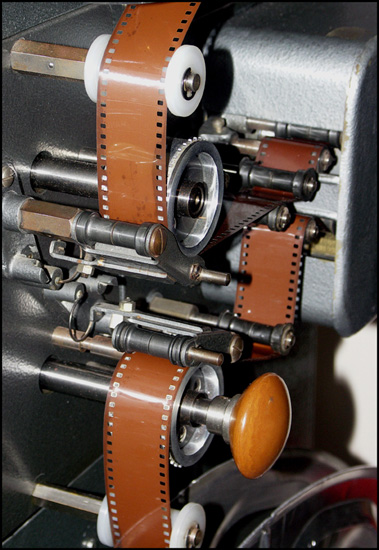 Cinerama
Magnetic Multi Channel Sound Reader Cinerama
Magnetic Multi Channel Sound ReaderAs well as The Widescreen Weekend 2012 these include: • Dave Strohmaier’s & Randy Gitsch’s personal crusade and collaboration with Cinerama Inc., and numerous contacts in Hollywood and around the world, to digitise the ten Cinerama feature films is nearing completion. How many will be released on DVD will depend on the sales of the initial two. • “This is Cinerama” & “Windjammer” are available for the first time this year on Blu-ray/DVD from an American company called Flicker Alley that say their mission is “to bring film history to new audiences”. The “Smilebox” aspect ratio simulation of the deeply curved screen is a really an interesting and effective innovation of simulating the impact of Cinerama on flat screens. www.flickeralley.com • The digital “This Is Cinerama” was showcased to an audience at BFI Southbank in London in early May. • As the September issue of CT magazine is being distributed and reaches the magazine shelves a week long celebration of Cinerama to mark its 60th anniversary is taking place at The Cinerama Dome in Hollywood. The Dome event is scheduled for Sept. 28th. through to Oct. 4th. It is set to include the première of the first film produced in “three strip” Cinerama for 50 years – the short subject “In The Picture.” • I cannot recommend Thomas Hauerslev’s website www.in70mm.com highly enough for more detailed information and updates about Cinerama, and more photos and details of Cinerama’s sixtieth anniversary celebrations and events. • “The Cinerama Story” a detailed booklet was advertised in the previous issue of CT magazine and is available from www.70mmpublishers.nl • Issue 22, of volume 8, of “Cinema Retro” magazine celebrates the 60th. anniversary of Cinerama and as well as interesting overview articles includes a richly illustrated ten page article on “How The West Was Won” by one of this year’s Widescreen Weekend delegates, Sir Christopher Frayling. uk email: solopublishing@gmail.com usa email: cinemaretro@hotmail.com • The conference of The Association of Moving Image Archivists takes place in Seattle in December which houses one of the three remaining public Cinerama cinemas in the world. Discussions and correspondence about possible Cinerama screenings then or in 2013 have taken place. Let us hope the Seattle Cinerama holds fast with its other two Cinerama compatriot cinemas and doesn’t let this important anniversary pass without marking it in some way with Cinerama screenings. |
|
| Go: back - top - back issues - news index Updated 22-01-25 |
